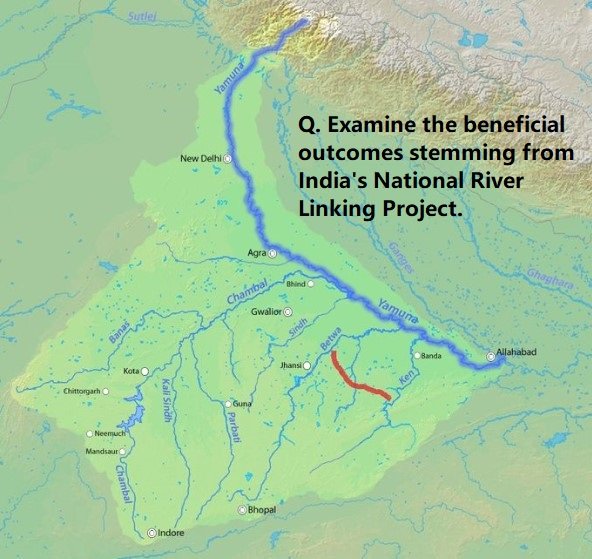AWIP, Economics, Environment & Ecology, Geography, Government Policies
Q. Examine the beneficial outcomes stemming from India’s National River Linking Project.
India’s National River Linking Project (NRLP) aims to transfer water from surplus river basins to water-deficit regions through a network of reservoirs and canals. This ambitious project, if implemented effectively, can have several beneficial outcomes:
1. Mitigation of Water Scarcity
- Equitable Water Distribution: The NRLP seeks to address the uneven distribution of water resources across the country by diverting water from regions with excess supply to areas facing chronic water shortages. This can alleviate water scarcity in arid and semi-arid regions, particularly in states like Rajasthan, Maharashtra, and Tamil Nadu.
- Augmented Irrigation: Enhanced irrigation potential can lead to increased agricultural productivity, enabling farmers in drought-prone areas to cultivate more land and grow multiple crops annually.
2. Flood Control
- Flood Management: The project can help mitigate the impact of floods in water-surplus regions like Assam, Bihar, and Uttar Pradesh by diverting excess water to water-deficient areas. This not only protects life and property but also reduces the economic losses associated with flood damage.
- Reservoirs and Dams: The construction of reservoirs and dams as part of the project can regulate river flow, helping to manage floodwaters more effectively.
3. Agricultural Benefits
- Increased Crop Production: Reliable and consistent water supply through interlinking canals can improve irrigation, leading to higher crop yields and increased agricultural output. This can boost food security and reduce dependency on monsoons.
- Diversification of Crops: With assured irrigation, farmers can diversify into high-value crops such as fruits, vegetables, and commercial crops, enhancing their income and reducing poverty.
4. Socio-Economic Development
- Employment Generation: The construction and maintenance of the NRLP infrastructure can create significant employment opportunities in rural areas, providing livelihoods to millions of people.
- Rural Development: Improved water availability can spur rural development by facilitating better sanitation, hygiene, and access to clean drinking water. This can lead to improved health outcomes and a higher quality of life for rural populations.
5. Industrial Growth
- Support for Industries: Enhanced water availability can support the growth of water-intensive industries, such as textiles, food processing, and chemicals, in water-scarce regions. This can promote balanced industrial development across the country.
- Hydropower Generation: The construction of dams and reservoirs as part of the NRLP can also facilitate the generation of hydropower, providing a renewable source of energy and reducing dependence on fossil fuels.
6. Environmental Benefits
- Restoration of Ecosystems: Properly managed water transfer can help restore ecosystems in drought-prone regions, supporting biodiversity and enhancing the health of wetlands and other aquatic habitats.
- Groundwater Recharge: Improved irrigation and water management practices can lead to better groundwater recharge, addressing the issue of depleting groundwater levels in many parts of India.
7. Climate Change Resilience
- Adaptation to Climate Variability: The NRLP can enhance India’s resilience to climate change by ensuring a more reliable and sustainable water supply, helping communities adapt to changing precipitation patterns and extreme weather events.
8. Inland Navigation
- Waterways Development: The interconnected network of rivers and canals can be developed for inland navigation, promoting an environmentally friendly and cost-effective mode of transportation for goods and people.
Conclusion
The National River Linking Project, despite its challenges and controversies, holds significant potential for addressing water scarcity, enhancing agricultural productivity, fostering socio-economic development, supporting industrial growth, and contributing to environmental sustainability. If implemented with careful planning, environmental safeguards, and equitable distribution mechanisms, the NRLP can bring about transformative benefits for India’s water management and overall development.


